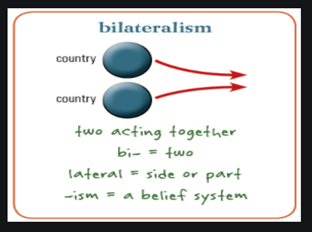Bilateralism is the practice of political, economic, or cultural association between two sovereign countries. It is distinct with unilateralism or multilateralism, which is activity by a single country or jointly by multiple country, respectively. When countries identify one another as sovereign country and consent to diplomatic relations, they make a bilateral relationship. States with bilateral relations will exchange diplomatic agents such as ambassadors to ease dialogues and co-operations.

Economic contracts, like free trade agreements (FTA) and foreign direct investment (FDI), signed by two countries, are a common instance of bilateralism. Because most economic contracts are signed according to the specific features of the agreeing countries to give favorable treatment to one another, not a universal concept but a situational differentiation is requires. Thus via bilateralism, countries can get more customized contracts and obligations that only apply to particular agreeing countries. But, the countries will face a trade-off since it is more improvident in transaction costs than the multilateral strategy. In a bilateral strategy, a new agreement has to be negotiated for each participating country. So it tends to be favored when transaction costs are less and the members are in surplus, which leads to “producer surplus” in economic terms, is high. Also, this will be efficient if an influential country wants control over small country from a liberalism point of view, since constructing a series of bilateral arrangements with small countries can exemplify a country’s influence.
History
There has been a long argument on the pros of bilateralism versus multilateralism. The initial failure of bilateralism came after the First World War when many politicians came to a conclusion that the complex pre-war system of bilateral ties had made war unavoidable. This resulted in the formation of the multilateral League of Nations (which was diluted due to incompetence after 26 years).
A similar result against bilateral trade contracts happened after the Great Depression, when it was debated that such contracts helped produce a cycle of rising tariffs that increased the economic decline. Hence, after the Second World War, the West moved to multilateral contracts like the General Agreement on Tariffs and Trade (GATT).

In spite of the high profile of modern multilateral systems such as the United Nations and World Trade Organization, most diplomacy still takes place at the bilateral level. Bilateralism has a plasticity and smoothness which is lacking in most compromise dependent multilateral systems. Additionally, discrepancies in power, resources, money, armament, or technology are more feasibly exploitable by the stronger side in bilateral diplomacy, which powerful countries might think of as a beneficial feature of it, as compared to the more majority consensus driven multilateral arrangement of diplomacy, where the single country -single vote rule is applied.
A 2017 research found that bilateral tax arrangements, even if planned to “coordinate policies between countries to avoid double taxation and encourage international investment”, had the unintended result of letting “multinationals to engage in treaty shopping, states’ fiscal autonomy is limited, and governments tend to maintain lower tax rates.”

Examples
India and Nepal have had a bilateral ties since antediluvian times, even before the birth of the lord Buddha in 544 BC. In contemporary times, this age old relationship has been upheld by written agreements. The India-Nepal treaty of friendship was inscribed in July of 1950. That furnished economically and politically important results for both nations. In 2011, the two nations signed a new Bilateral Investment Promotion and Protection Agreement. These bilateral agreements have played an important role in the evolution of international investment law. Citizens of both nations can move across the border freely without passport or visa, live and work in either country and own property or business in either country. Gurkhas form a part of the Indian Army are of Nepali descent. Millions of Nepalis have been living in India for long periods of time and have become an integral part of our country.
By: Aakanksha Chaturvedi

